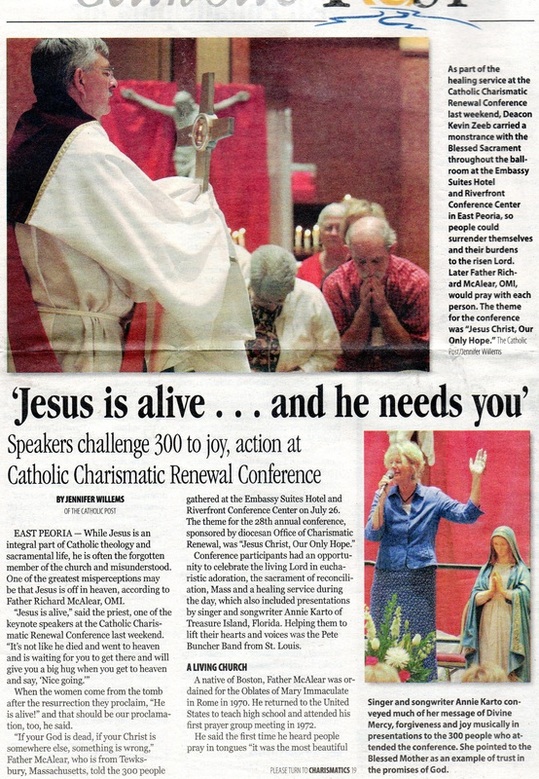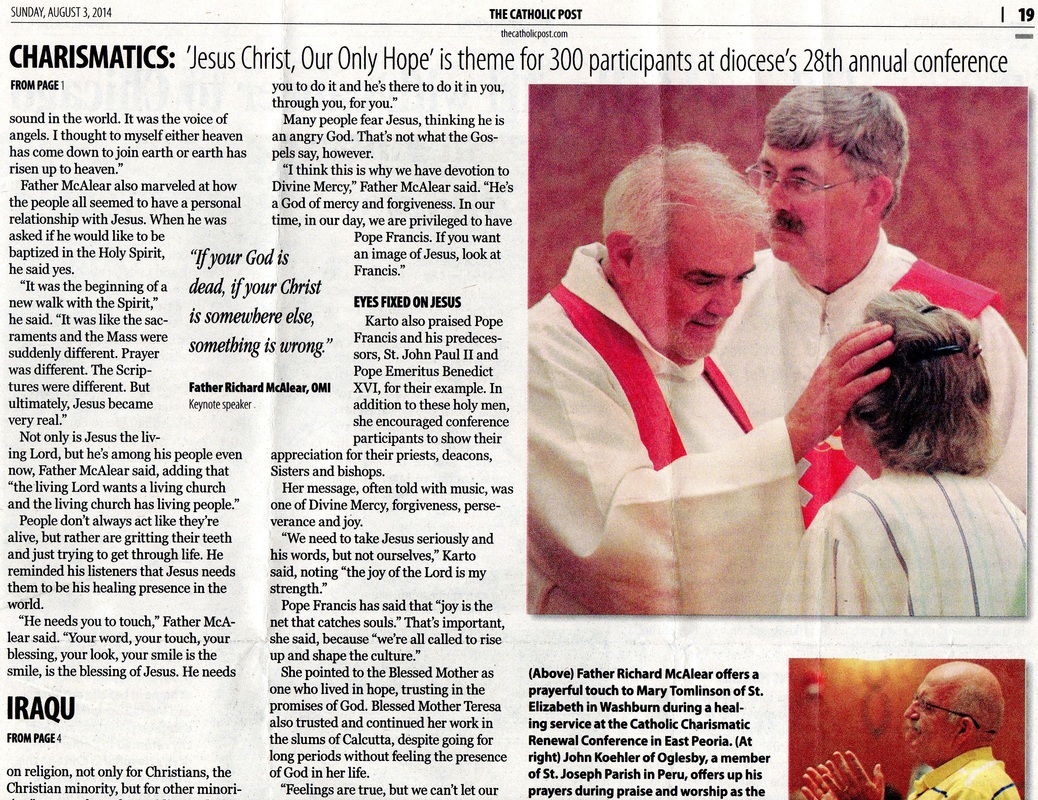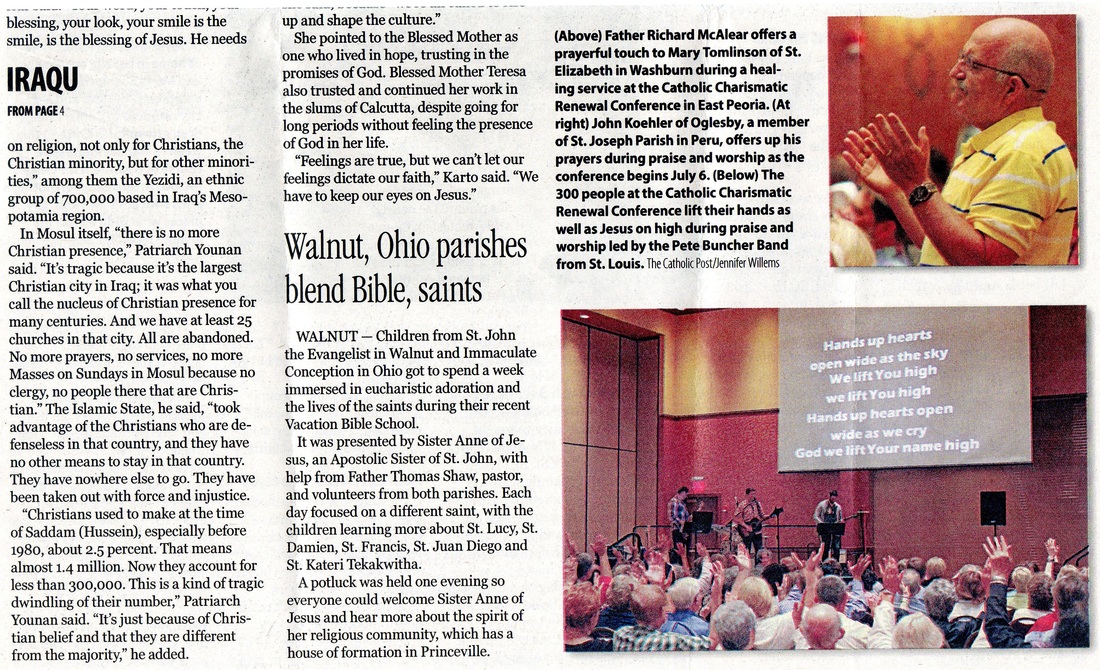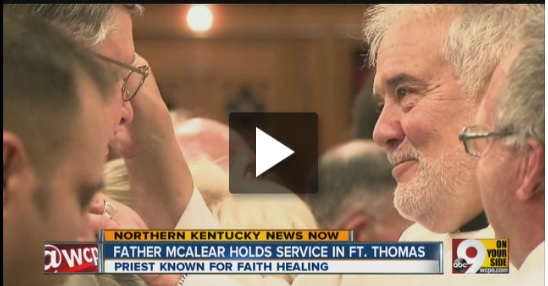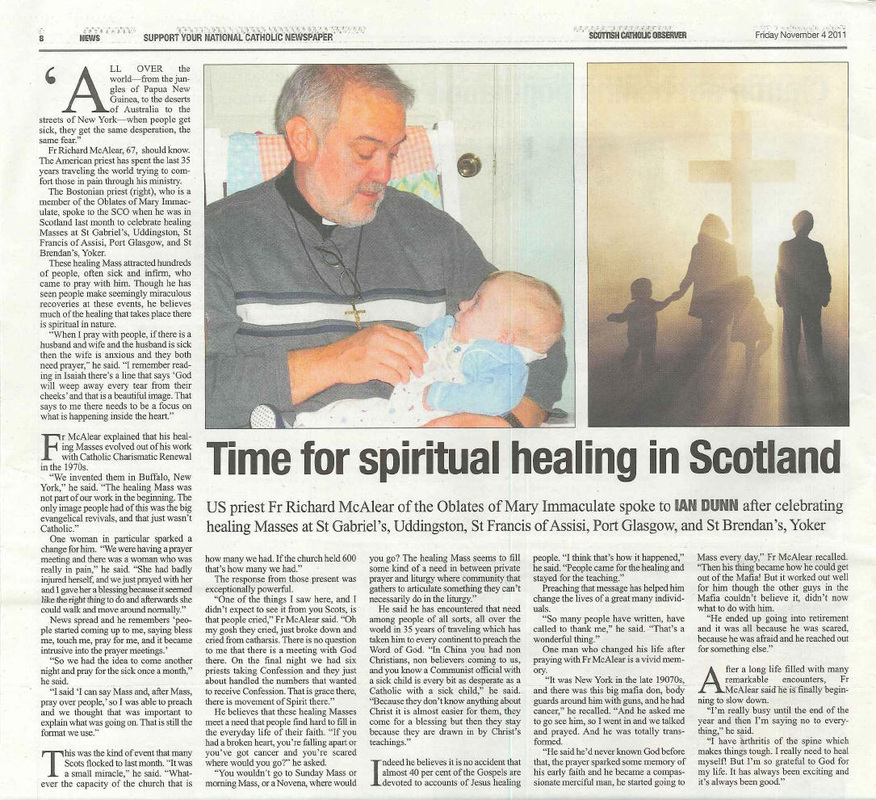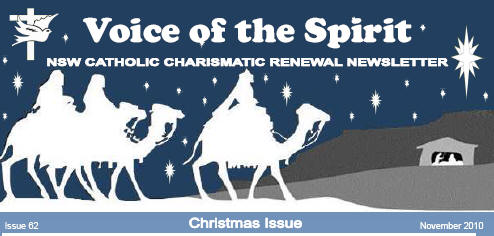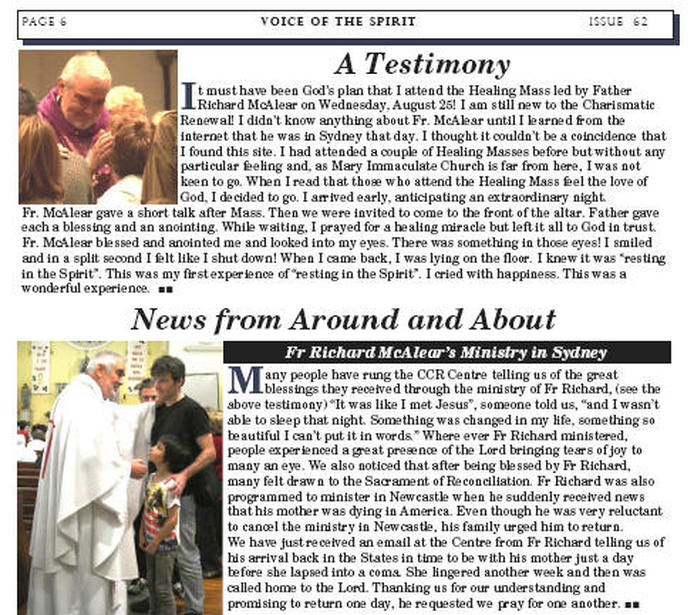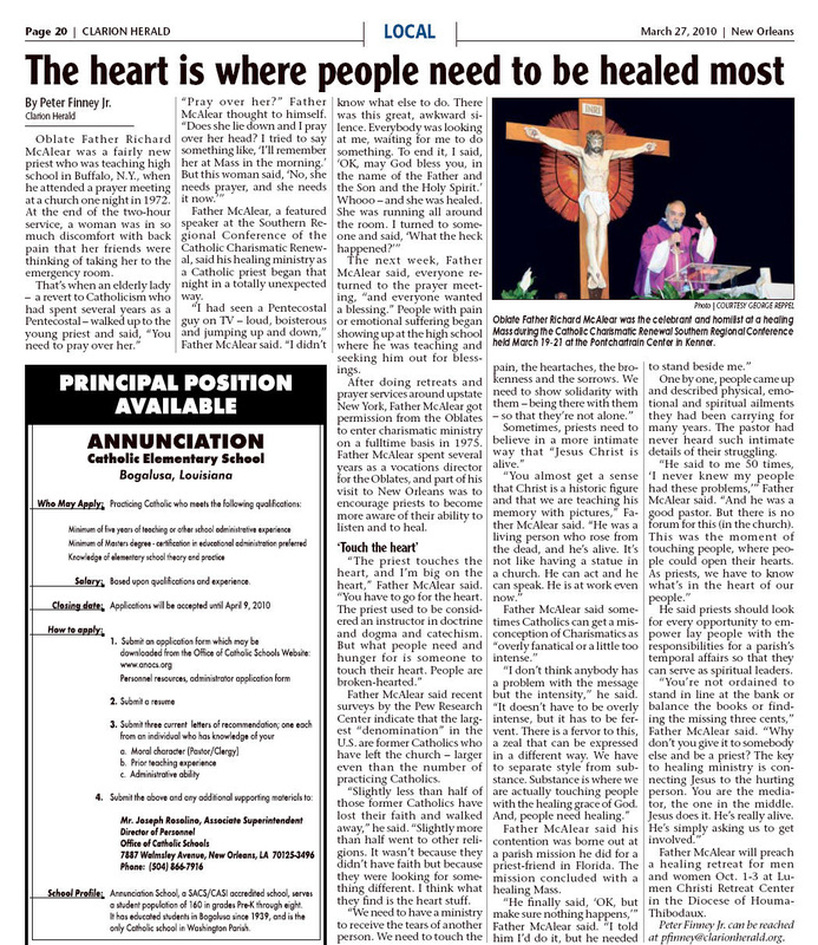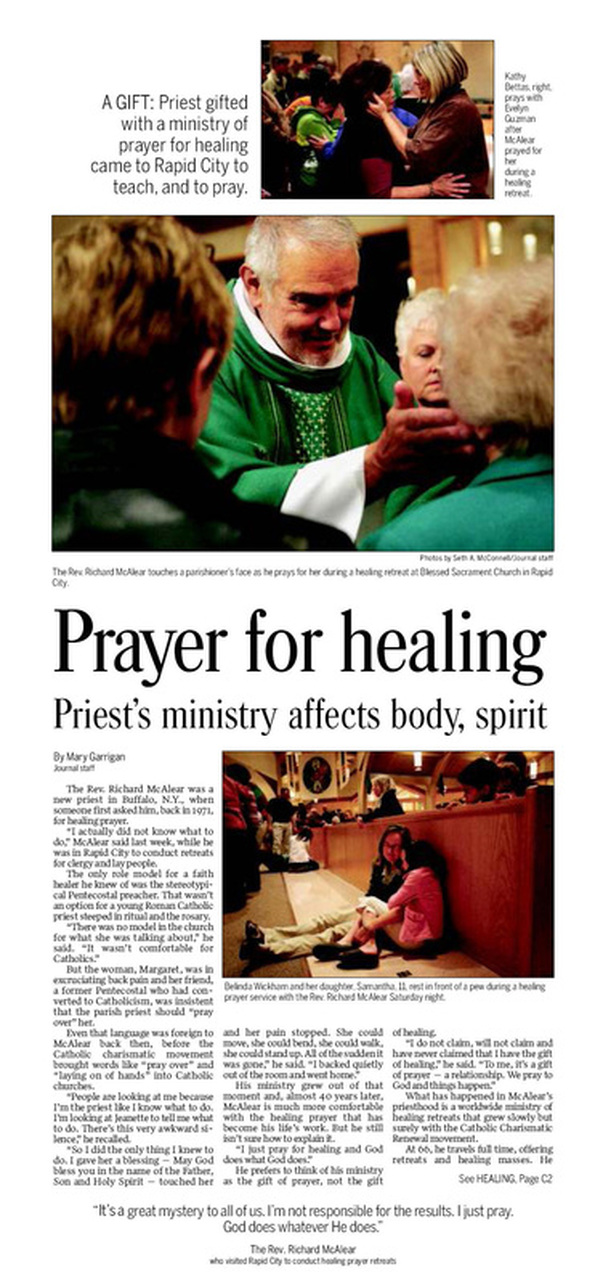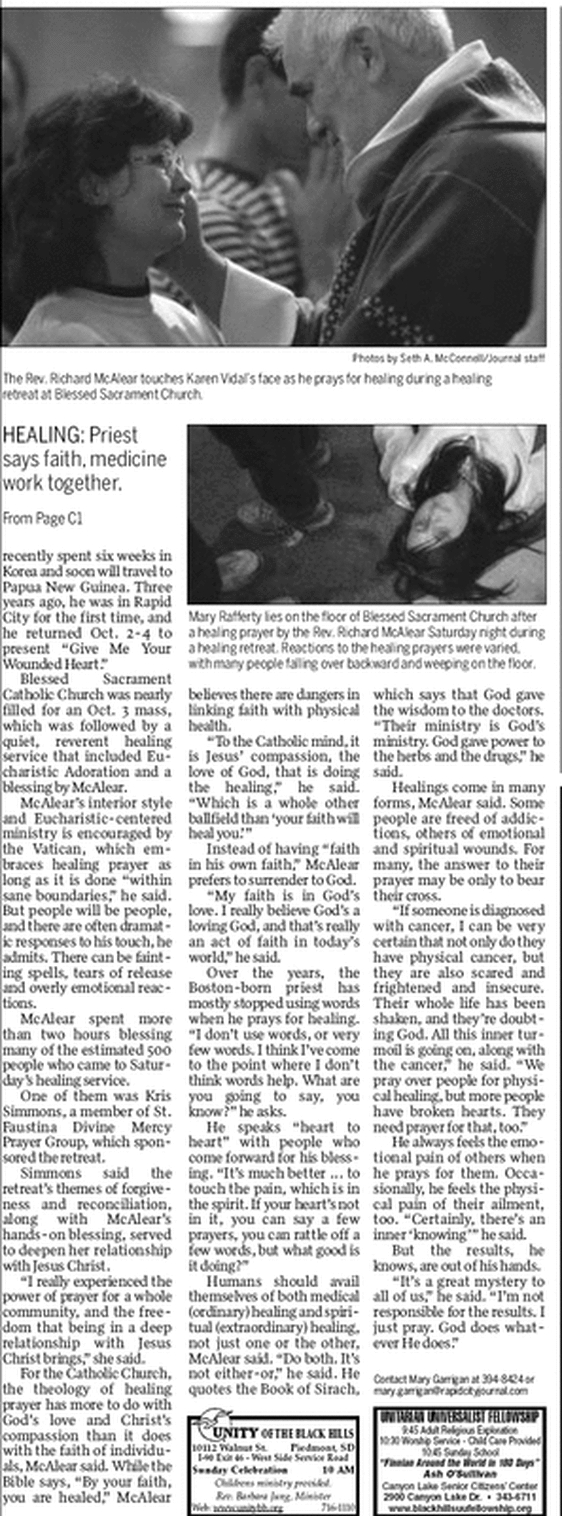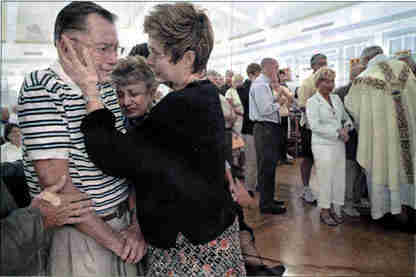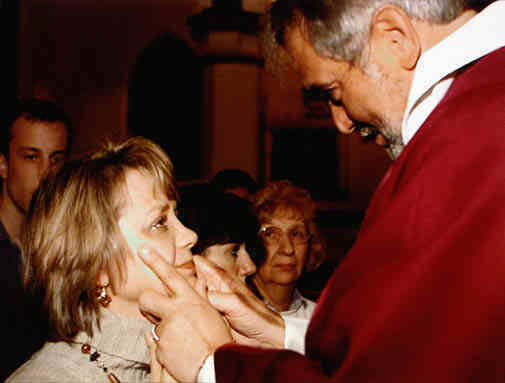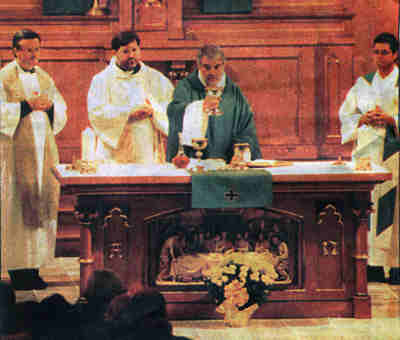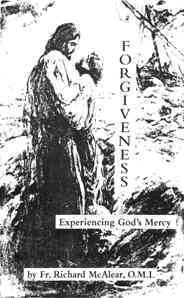In the News
Below are a few of the many articles that have been written about Fr. McAlear and his Ministry of Hope and Healing.
__________________________________________________________________________
The Catholic Post -- Newspaper of the Diocese of Peoria, August 3, 2014
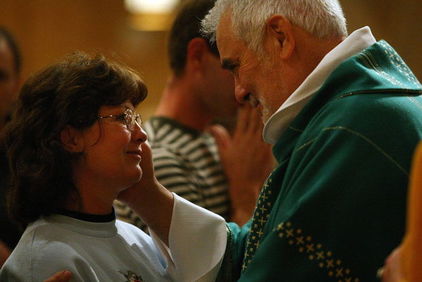
MESSAGES OF HOPE - Rapid City Journal
September 05, 2015 4:00 am • Bev Pechan Journal correspondent If you go For more information or to register for the retreat, contact Beth Strain at 342-0507. An 18-part course on the Rev. Richard McAlear’s healing ministry is available free-of-charge online at frmac.org/listen-to-ministry-healing-course-for-free.
“People have said they see Jesus’s eyes in his eyes,” Halina Hladysz says of the Rev. Richard McAlear.
Her family is one of thousands who have witnessed “Father Mac’s” healing power by watching loved ones made whole again after attending one of his prayer masses or healing retreats.
McAlear is holding a healing retreat titled “Come to Me All Who Are Weary” from Sept. 11 to 12 at the Cathedral of Perpetual Help on Cathedral Drive. McAlear has previously offered messages of hope in Rapid City in 2006, 2009 and 2011.
So far this year, he has traveled to Australia and held retreats in at least a dozen states and Sao Paolo, Brazil. There is no charge for the Rapid City retreat, and it is open to all faiths and people from all walks of life.
Originally from the Boston area, McAlear says on his website that he experienced his first healing miracle when he prayed for a dying woman who recovered. “I have a ringside seat to something going on. I know something is going on. Something is happening,” he said.
Hladysz and her late husband came to the U.S. from Poland about 30 years ago. For 16 years, she wrote a column for the Journal on health and healing. Several years ago, Hladysz learned that McAlear was going to hold a retreat in Yankton and she attended, carrying a letter in her hand she hoped to present as a healing prayer request for another person.
During a break, Hladysz handed McAlear letter as he mingled. “I found him very sweet ,” she said. “I was shy, and he was kind and fatherly to me.”
A few weeks later, the Hladysz family received a postcard from McAlear, telling them that he had the photo she had given him on his desk and was saying prayers for healing. “He goes all over the world. I didn’t think he would personally acknowledge us," Hladysz said.
Hladysz said that while she cannot compare him with Jesus, McAlear's lifework is very similar as he goes out among the people, offering prayers and words of encouragement to help them deal with personal burdens. Numerous testimonials are posted online from those who have seen positive changes and healing. Many are from cancer sufferers who claim they have been cured.
Before leaving for Rome recently, the Rev. Michael Mulloy, rector of Our Lady of Perpetual Help, said "healing is something desperately needed in our world today. We have marvelous abilities to heal physically, but the healing of spirit and soul requires more than our human ingenuity. Father McAlear has been gifted with being a channel of God’s mercy and love.
"Through his talks, the sacrament of reconciliation, the celebration of the mass and the healing service itself, God will bless us with his presence. I am excited to have Father McAlear come to the Cathedral. It will be a restful and peaceful time of prayer and fellowship. I hope the Cathedral will be filled with many people who will experience this wonderful opportunity.”
NOVEMBER 22, 2013 - WCPO CINCINNATI
http://www.wcpo.com/news/local-news/man-known-as-healing-priest-makes-stop-in-northern-kentucky#.UpAhXWPVyuM.email
FORT THOMAS, Ky. -- Father Richard McAlear visited Northern Kentucky Thursday
evening, where he held a service at St. Thomas Church in Fort Thomas.
He prayed for all 200 people in attendance.
Originally from Boston, Father McAlear has traveled the world, taking his
healing powers with him. He said he experienced his first miracle more than 40
years ago, when he prayed for a woman who was dying and she was cured.
RELATED: Healing priest returns to Northern
Kentucky
Those who attended Thursday's service told WCPO reporter Natasha Williams
that they truly believe in Father McAlear's power of prayer and healing.
For Michelle Krenner, her trip to St. Thomas Church was a small miracle in
itself, as she was already planning to travel to Connecticut to see Father
McAlear. Krenner has followed Father McAlear's ministries for more than a year.
Learning he was coming to her hometown was everything she could have hoped
for.
"You feel like an, overwhelming, all over your body," Krenner said, "and you
almost want to fall backwards."
When Father McAlear started preaching, it was nothing he had planned. He
recalled his early practice as one where he just gave a blessing, because he had
no teaching or background in prayer.
"It scared me more than it scared anybody," Father McAlear said.
He's been as far as South Korea and New Guinea to speak to, touch and heel
crowds of people. No matter where he goes, he said the feeling stays the
same.
"It's almost like I'm not doing anything, like I'm watching something
happen," he said. "I have a ringside seat to something going on. I know
something is going on, something's happening, and I know people are being
touched."
Margie Neltner saw Father McAlear for the second time Thursday.
"It was just amazing when he was at St. Joe's and my heart was healed," she
said.
"It's such a blessing that he's so gifted."
http://www.wcpo.com/news/local-news/man-known-as-healing-priest-makes-stop-in-northern-kentucky#.UpAhXWPVyuM.email
FORT THOMAS, Ky. -- Father Richard McAlear visited Northern Kentucky Thursday
evening, where he held a service at St. Thomas Church in Fort Thomas.
He prayed for all 200 people in attendance.
Originally from Boston, Father McAlear has traveled the world, taking his
healing powers with him. He said he experienced his first miracle more than 40
years ago, when he prayed for a woman who was dying and she was cured.
RELATED: Healing priest returns to Northern
Kentucky
Those who attended Thursday's service told WCPO reporter Natasha Williams
that they truly believe in Father McAlear's power of prayer and healing.
For Michelle Krenner, her trip to St. Thomas Church was a small miracle in
itself, as she was already planning to travel to Connecticut to see Father
McAlear. Krenner has followed Father McAlear's ministries for more than a year.
Learning he was coming to her hometown was everything she could have hoped
for.
"You feel like an, overwhelming, all over your body," Krenner said, "and you
almost want to fall backwards."
When Father McAlear started preaching, it was nothing he had planned. He
recalled his early practice as one where he just gave a blessing, because he had
no teaching or background in prayer.
"It scared me more than it scared anybody," Father McAlear said.
He's been as far as South Korea and New Guinea to speak to, touch and heel
crowds of people. No matter where he goes, he said the feeling stays the
same.
"It's almost like I'm not doing anything, like I'm watching something
happen," he said. "I have a ringside seat to something going on. I know
something is going on, something's happening, and I know people are being
touched."
Margie Neltner saw Father McAlear for the second time Thursday.
"It was just amazing when he was at St. Joe's and my heart was healed," she
said.
"It's such a blessing that he's so gifted."
National
Catholic Register
At the Touch of the Great Physicians
What to Expect (and What Not to) at a Healing Mass
BY JOSEPH PRONECHEN
February 10-16, 2008 Issue | Posted 2/5/08 at 12:28 PM
Come Monday, Feb. 11 — feast of Our Lady of Lourdes and World Day of the Sick —
thousands will descend on the famous shrine in Lourdes, France, to celebrate the
150th anniversary of the Marian apparitions in a small grotto.
Most will also seek to touch, collect or even drink from the famous spring whose
water is said to have delivered physical healings to countless people since St.
Bernadette Soubirous brought it to the world’s attention in 1858.
But millions cannot get to Lourdes. Where do they go for hope and healings?
Anywhere a healing Mass is celebrated.
And what should the “hopeful faithful” expect at these sacramental services?
Certainly not the sort of theatricality and histrionics seen on many televangelism broadcasts.
What, then? Father Richard McAlear of the Oblates of Mary Immaculate can tell us
first-hand. From the churches of America to the other side of the world,
including Papua New Guinea and China, he has conducted an international healing
ministry since the 1970s. (He’s now online at FrMac.org.)
Father McAlear begins his answer by pointing out Pope Benedict’s frequent exhortations
to “experience God.”
“You can talk about God, but at some point people need to experience him, and that’s
what the healing Mass does,” says the priest. “It is an immediate way of
experiencing God.”
The Catechism backs him up. “In the sacraments Christ continues to‘touch’ us in
order to heal us,” we read in No. 1504. “The Holy Spirit gives to some a special
charism of healing,” adds No. 1508, “so as to make manifest the power of the
grace of the risen Lord.”
Father McAlear and other healing priests say they’ve seen dramatic physical healings
from cancer, leukemia, blindness and heart problems —especially among the poor
and in mission countries. But those kinds of deliverances are not the “be all
and end all” of the sacrament of the anointing of the sick.
“It’s what is going on inside — the inner pain, depression, sadness, grief, loss,
loneliness,” explains Father McAlear, quoting Isaiah 61:1, and saying the most
important healing is of the heart. “A lot of times it’s manifested in physical
illness. The need is there to touch the heart and the inner spirit. That’s where
the healing Masses make their contribution,” he says. “The spiritual need can
only be touched spiritually. Then everything else follows. The hope is restored,
the darkness is lifted.”
Giving Us Rest
“The physical healing is a real blessing but that’s only temporary; you’re going to
die and the healing is not going to make a difference,” says Father Robert
Rousseau, pastor of St. Augustine Catholic Church in North Branford, Conn., who
has held monthly healing Masses for more than 20 years. “The most important
healing is the one that brings us closer to the Lord.”
During the prayer after Mass and prayer in the presence of the exposed Blessed
Sacrament — a common practice among healing priests, who usually seek to
emphasize Jesus as the Great Physician — people experience a deep sense of
peace, says Father Rousseau.
Sometimes, when hands are laid on them or chrism oil is applied during the Mass, they “rest
in the spirit.” That’s another way of saying that some drop to the floor as if
in sudden sleep.
Father Rousseau makes clear that such a phenomenon is nothing to be afraid of; nor
should those who do not fall backwards feel as though they’re doing something
wrong. “God can heal the way he wants,” he says. “He treats everybody
individually.”
Sometimes these healings combine the physical and spiritual in astonishing ways.
One stands out for John Botaish, president of the Lourdes Marian Center in Denver.
He describes the incident, which happened during the years he was assisting the
Center’s recently retired Father Michael Walsh.
A young nun in a major congregation was extremely wheat-intolerant and could only
receive the Precious Blood, recalls Botaish. She strongly desired to receive the
Sacred Host. The day after Father Walsh prayed for her, she could. And she also
ate pasta.
“Her desire wasn’t to consume wheat products but to receive the Eucharist in the
standard species in the normal way everyone else did,” says Botaish. “The prayer
was answered in a very intimate way by Christ.”
And then there’s the Marian-intercession aspect of healings at Masses.
“Lourdes is the perfect example,” Father McAlear explains. “It’s absolutely Marian front
and center, and yet absolutely Christ-centered. This is a perfect combination of
the presence of Christ the savoir, Christ the healer, and Mary — who kind of
owns the place. She never obstructs Jesus or gets in his way. The priests at
Lourdes tell me the healings happen when they bring the Eucharist out. The focal
point of the healing is usually around the Eucharist.”
No one knows better than Father Roy Henderson of St. Andrew Catholic Church in
Bridgeport, Conn. When he was a teen and met a little boy named Chris who had
cancer of the stomach, back and brain, he remembered something his mother said
to him as a young boy.
They were Methodists, but, showing him a picture of Lourdes, she told him, “One day
you are going to go there.” As the 18-year-old, Henderson decided to get Chris
to Lourdes but the boy was too sick to travel. Young Henderson flew alone to get
a bottle of water from Lourdes.
After he did, he decided to let the water dribble slowly over his own left hand. He
was born with severe cerebral palsy and had no bones, only cartilage, in the
fingers of his hand.
Here’s how he describes what happened next: “My whole arm stretched out like someone
was pulling it. My fingers popped like popcorn from the inside out. The bones
grew! There was no pain. My arm’s not perfect, but as I tell the young kids
today, God enabled me to do the one thing I need to do as a priest: say Mass.
God doesn’t want perfection; he just wants willing respondents.”
“I couldn’t be a Methodist and a minister and still pray the Rosary and honor Our
Lady of Lourdes with prayers,” says Father Henderson. He became Catholic and
answered God’s call to the priesthood.
His own healing gift broke out one year after he went to Lourdes. For the past 17
years, he has celebrated healing Masses in his diocese and in several other
states.
Today he says of Our Lady of Lourdes, “She is the stem of my chalice.” And the healing
he’s most grateful for? “She brought to me the reality of the Eucharist.”
One needn’t travel to France for that greatest of all healing touches.
Staff writer Joseph Pronechen
writes from Trumbull, Connecticut.
Catholic Register
At the Touch of the Great Physicians
What to Expect (and What Not to) at a Healing Mass
BY JOSEPH PRONECHEN
February 10-16, 2008 Issue | Posted 2/5/08 at 12:28 PM
Come Monday, Feb. 11 — feast of Our Lady of Lourdes and World Day of the Sick —
thousands will descend on the famous shrine in Lourdes, France, to celebrate the
150th anniversary of the Marian apparitions in a small grotto.
Most will also seek to touch, collect or even drink from the famous spring whose
water is said to have delivered physical healings to countless people since St.
Bernadette Soubirous brought it to the world’s attention in 1858.
But millions cannot get to Lourdes. Where do they go for hope and healings?
Anywhere a healing Mass is celebrated.
And what should the “hopeful faithful” expect at these sacramental services?
Certainly not the sort of theatricality and histrionics seen on many televangelism broadcasts.
What, then? Father Richard McAlear of the Oblates of Mary Immaculate can tell us
first-hand. From the churches of America to the other side of the world,
including Papua New Guinea and China, he has conducted an international healing
ministry since the 1970s. (He’s now online at FrMac.org.)
Father McAlear begins his answer by pointing out Pope Benedict’s frequent exhortations
to “experience God.”
“You can talk about God, but at some point people need to experience him, and that’s
what the healing Mass does,” says the priest. “It is an immediate way of
experiencing God.”
The Catechism backs him up. “In the sacraments Christ continues to‘touch’ us in
order to heal us,” we read in No. 1504. “The Holy Spirit gives to some a special
charism of healing,” adds No. 1508, “so as to make manifest the power of the
grace of the risen Lord.”
Father McAlear and other healing priests say they’ve seen dramatic physical healings
from cancer, leukemia, blindness and heart problems —especially among the poor
and in mission countries. But those kinds of deliverances are not the “be all
and end all” of the sacrament of the anointing of the sick.
“It’s what is going on inside — the inner pain, depression, sadness, grief, loss,
loneliness,” explains Father McAlear, quoting Isaiah 61:1, and saying the most
important healing is of the heart. “A lot of times it’s manifested in physical
illness. The need is there to touch the heart and the inner spirit. That’s where
the healing Masses make their contribution,” he says. “The spiritual need can
only be touched spiritually. Then everything else follows. The hope is restored,
the darkness is lifted.”
Giving Us Rest
“The physical healing is a real blessing but that’s only temporary; you’re going to
die and the healing is not going to make a difference,” says Father Robert
Rousseau, pastor of St. Augustine Catholic Church in North Branford, Conn., who
has held monthly healing Masses for more than 20 years. “The most important
healing is the one that brings us closer to the Lord.”
During the prayer after Mass and prayer in the presence of the exposed Blessed
Sacrament — a common practice among healing priests, who usually seek to
emphasize Jesus as the Great Physician — people experience a deep sense of
peace, says Father Rousseau.
Sometimes, when hands are laid on them or chrism oil is applied during the Mass, they “rest
in the spirit.” That’s another way of saying that some drop to the floor as if
in sudden sleep.
Father Rousseau makes clear that such a phenomenon is nothing to be afraid of; nor
should those who do not fall backwards feel as though they’re doing something
wrong. “God can heal the way he wants,” he says. “He treats everybody
individually.”
Sometimes these healings combine the physical and spiritual in astonishing ways.
One stands out for John Botaish, president of the Lourdes Marian Center in Denver.
He describes the incident, which happened during the years he was assisting the
Center’s recently retired Father Michael Walsh.
A young nun in a major congregation was extremely wheat-intolerant and could only
receive the Precious Blood, recalls Botaish. She strongly desired to receive the
Sacred Host. The day after Father Walsh prayed for her, she could. And she also
ate pasta.
“Her desire wasn’t to consume wheat products but to receive the Eucharist in the
standard species in the normal way everyone else did,” says Botaish. “The prayer
was answered in a very intimate way by Christ.”
And then there’s the Marian-intercession aspect of healings at Masses.
“Lourdes is the perfect example,” Father McAlear explains. “It’s absolutely Marian front
and center, and yet absolutely Christ-centered. This is a perfect combination of
the presence of Christ the savoir, Christ the healer, and Mary — who kind of
owns the place. She never obstructs Jesus or gets in his way. The priests at
Lourdes tell me the healings happen when they bring the Eucharist out. The focal
point of the healing is usually around the Eucharist.”
No one knows better than Father Roy Henderson of St. Andrew Catholic Church in
Bridgeport, Conn. When he was a teen and met a little boy named Chris who had
cancer of the stomach, back and brain, he remembered something his mother said
to him as a young boy.
They were Methodists, but, showing him a picture of Lourdes, she told him, “One day
you are going to go there.” As the 18-year-old, Henderson decided to get Chris
to Lourdes but the boy was too sick to travel. Young Henderson flew alone to get
a bottle of water from Lourdes.
After he did, he decided to let the water dribble slowly over his own left hand. He
was born with severe cerebral palsy and had no bones, only cartilage, in the
fingers of his hand.
Here’s how he describes what happened next: “My whole arm stretched out like someone
was pulling it. My fingers popped like popcorn from the inside out. The bones
grew! There was no pain. My arm’s not perfect, but as I tell the young kids
today, God enabled me to do the one thing I need to do as a priest: say Mass.
God doesn’t want perfection; he just wants willing respondents.”
“I couldn’t be a Methodist and a minister and still pray the Rosary and honor Our
Lady of Lourdes with prayers,” says Father Henderson. He became Catholic and
answered God’s call to the priesthood.
His own healing gift broke out one year after he went to Lourdes. For the past 17
years, he has celebrated healing Masses in his diocese and in several other
states.
Today he says of Our Lady of Lourdes, “She is the stem of my chalice.” And the healing
he’s most grateful for? “She brought to me the reality of the Eucharist.”
One needn’t travel to France for that greatest of all healing touches.
Staff writer Joseph Pronechen
writes from Trumbull, Connecticut.
On May 8th of 2006, Naples Daily News (Naples, Florida) featured this
article on Fr. Richard McAlear:
The Rev. Richard McAlear, who lives half the year at Ave Maria, travels the
world sharing his gift
By Jenna Buzzacco
Alice Suki cried when the Rev. Richard McAlear
touched her head. Nearby, people were lying on the floor of Stella
Maris chapel, crying and praying. Others swooped in to lighten their
fall, wipe their tears or say a prayer. For McAlear, the Mass on
April 30 was not out of the ordinary.
A member of the healing ministry since 1976, McAlear
performs hundred of healing masses a year. A part-time
priest-in-residence at Ave Maria University, McAlear spent the past
few months sharing his gift with the Southwest Florida community.
To some, McAlear is simply a
healer. "You don't think nothing happens at first," said John
Ganzelli, 51, of Naples. "It's all supernatural stuff. It's
incredible."
Ganzelli has attended four services this year. He said
he didn't think the service helped, but soon his prayers of recovery
came true. "I don't know if these are miracles, but they sure are
something," McAlear said. At first, the mass looks like every other
mass on Ave Maria's North Naples campus. The process is the same,
expect after communion, visitors have the chance to leave or stay
and be prayed over. Most, McAlear said, choose to stay.
On April 30, Stella Maris overflowed with people
looking for help. Some had physical ailments, while others had
emotional issues. And still others wanted nothing more then a
blessing. Rosemary Benavitz of Naples sat in the front row with her
17-month-old daughter, Mary Grace, in her lap. Mary Grace was born with
Down Syndrome, and Benavitz has been brining her to McAlear's masses since
she was three weeks old. "I don't come here looking for a cure for
her," Benavitz said. "This is a holy man giving a blessing from God and
I just wanted him to give Mary Grace a blessing."
It only takes a few seconds, but most leave feeling
blessed, McAlear said.
"God's blessing upon you," McAlear said as
he put his hands on Suki's head. "Peace." Suki, 64, of Naples, did
not attend the mass to be healed. Instead, she said she hoped to spread
her good wealth to others. "This is my first time, other then the
time I took my mother-in-law, coming to a healing mass." she said.
"Nothing is wrong with me. God has just been so good to me, I really feel
I need to come and share."
The Catholic Charismatic Renewal began in 1967 after a
retreat held at Duquense University in Pittsburgh. As the movement
grew, it gained recognition in the church and among its
leadership. According to the National Service Committee of the
Catholic Charismatic Renewal, the United States Conference of
Catholic Bishops issued a statement in 1969 stating that the charismatic
movement "has legitimate reasons of existence. It has strong Biblical
basis."
The gift of healing isn't exclusive to clergy people,
McAlear said. "There are quite a few lay people who have this gift,"
he said. "If you have a gift of healing, get up and use
it." McAlear said he didn't always use his gift. Until the
mid-1970s, McAlear said he rarely prayed over people, afraid his
gift would get him unneeded attention. That isn't the case now,
though.
McAlear spends half of the year in Southwest Florida,
the other half he travels around the world performing ceremonies
everywhere from Catholic churches to rain forests. And McAlear said it's
the work in the underdeveloped parts of the world that hits home the
most with him. "In my experience, in the mission fields this is how
they evangelize," McAlear said. "Healing is to affirm God's
presence, in the mission fields there's healing galore."
McAlear has traveled to New Guinea, Korea and Guatemala
to perform the Masses. In Korea, he said he met a woman who kept
asking which one of the priests was Jesus. McAlear said he just pointed
up. The healing masses make up for the lack medical aid in
impoverished countries, McAlear said. While the people attending
McAlear's masses stateside generally have access to medical care, they're
looking to fill a void, he said. "Most people are hurting, they have
a fear of the future," he said. "(I pray for) all of those inner
things and we leave with a whole new energy. Every once in a while
you get a miracle, but what I discovered is words don't heal, love
heals."
Marylin Krepf of Naples assists McAlear during his
masses. Krepf has been attending healing masses for three years and
she knows it isn't McAlear, but his love of people, that is doing the
healing. "Father McAlear is the instrument for God to heal hearts,"
she said. "He knows it is God doing the healing, you can almost feel
embraced by God. This is an amazing, different kind of love. I invite
everyone I meet because I want them to experience this kind of
love."
touched her head. Nearby, people were lying on the floor of Stella
Maris chapel, crying and praying. Others swooped in to lighten their
fall, wipe their tears or say a prayer. For McAlear, the Mass on
April 30 was not out of the ordinary.
A member of the healing ministry since 1976, McAlear
performs hundred of healing masses a year. A part-time
priest-in-residence at Ave Maria University, McAlear spent the past
few months sharing his gift with the Southwest Florida community.
To some, McAlear is simply a
healer. "You don't think nothing happens at first," said John
Ganzelli, 51, of Naples. "It's all supernatural stuff. It's
incredible."
Ganzelli has attended four services this year. He said
he didn't think the service helped, but soon his prayers of recovery
came true. "I don't know if these are miracles, but they sure are
something," McAlear said. At first, the mass looks like every other
mass on Ave Maria's North Naples campus. The process is the same,
expect after communion, visitors have the chance to leave or stay
and be prayed over. Most, McAlear said, choose to stay.
On April 30, Stella Maris overflowed with people
looking for help. Some had physical ailments, while others had
emotional issues. And still others wanted nothing more then a
blessing. Rosemary Benavitz of Naples sat in the front row with her
17-month-old daughter, Mary Grace, in her lap. Mary Grace was born with
Down Syndrome, and Benavitz has been brining her to McAlear's masses since
she was three weeks old. "I don't come here looking for a cure for
her," Benavitz said. "This is a holy man giving a blessing from God and
I just wanted him to give Mary Grace a blessing."
It only takes a few seconds, but most leave feeling
blessed, McAlear said.
"God's blessing upon you," McAlear said as
he put his hands on Suki's head. "Peace." Suki, 64, of Naples, did
not attend the mass to be healed. Instead, she said she hoped to spread
her good wealth to others. "This is my first time, other then the
time I took my mother-in-law, coming to a healing mass." she said.
"Nothing is wrong with me. God has just been so good to me, I really feel
I need to come and share."
The Catholic Charismatic Renewal began in 1967 after a
retreat held at Duquense University in Pittsburgh. As the movement
grew, it gained recognition in the church and among its
leadership. According to the National Service Committee of the
Catholic Charismatic Renewal, the United States Conference of
Catholic Bishops issued a statement in 1969 stating that the charismatic
movement "has legitimate reasons of existence. It has strong Biblical
basis."
The gift of healing isn't exclusive to clergy people,
McAlear said. "There are quite a few lay people who have this gift,"
he said. "If you have a gift of healing, get up and use
it." McAlear said he didn't always use his gift. Until the
mid-1970s, McAlear said he rarely prayed over people, afraid his
gift would get him unneeded attention. That isn't the case now,
though.
McAlear spends half of the year in Southwest Florida,
the other half he travels around the world performing ceremonies
everywhere from Catholic churches to rain forests. And McAlear said it's
the work in the underdeveloped parts of the world that hits home the
most with him. "In my experience, in the mission fields this is how
they evangelize," McAlear said. "Healing is to affirm God's
presence, in the mission fields there's healing galore."
McAlear has traveled to New Guinea, Korea and Guatemala
to perform the Masses. In Korea, he said he met a woman who kept
asking which one of the priests was Jesus. McAlear said he just pointed
up. The healing masses make up for the lack medical aid in
impoverished countries, McAlear said. While the people attending
McAlear's masses stateside generally have access to medical care, they're
looking to fill a void, he said. "Most people are hurting, they have
a fear of the future," he said. "(I pray for) all of those inner
things and we leave with a whole new energy. Every once in a while
you get a miracle, but what I discovered is words don't heal, love
heals."
Marylin Krepf of Naples assists McAlear during his
masses. Krepf has been attending healing masses for three years and
she knows it isn't McAlear, but his love of people, that is doing the
healing. "Father McAlear is the instrument for God to heal hearts,"
she said. "He knows it is God doing the healing, you can almost feel
embraced by God. This is an amazing, different kind of love. I invite
everyone I meet because I want them to experience this kind of
love."
In Wednesday, December 3, 2003, the
Rochester (New York) Democrat and Chronicle featured this article on
Father McAlear:
Healing ministry returns to area
By Staff Writer
Marketta Gregory
The Rev. Richard McAlear travels the world because
people are hungry for what he has to offer: peace, tranquility,
love, healing. If the past is any indicator, people searching for help
will find it when McAlear visits the area this week to celebrate
Mass and offer blessings.
"I definitely got a healing myself," said Marian
Battle, head of interior design for the church proper at St. Louis
Church in Pittsford. "I first met him in the '90s and I personally was
having some difficult times." Battle's husband of 32 years had died and she
needed - and said she received - emotional healing.
McAlear, a Boston native who was ordained a Roman
Catholic priest in 1970, began his healing ministry six years later. He
is a member of Oblate of Mary Immaculate order.
Often, move than 1,000 people gather to see the priest,
who gives the credit to God for healings. Last year, about 1,300
came to St. Mark Church in Greece, including a woman who asked if Battle
could help her get to the service. The woman wasn't Catholic and "had not
had God in her thoughts for years," Battle said, but got what she
was looking for.
"People are looking for healing and teaching, and they
want to be loved by Jesus Christ," said Elfie Davis, a parishioner
at St. Louis Church and a friend of McAlear. Davis found healing from
memories of World War II that she could barely talk about before. "I
think that the hand of God truly reaches out to those that really
believe," Battle said, adding that there's an aura of spirituality and
calmness when McAlear visits the church.
Rochester (New York) Democrat and Chronicle featured this article on
Father McAlear:
Healing ministry returns to area
By Staff Writer
Marketta Gregory
The Rev. Richard McAlear travels the world because
people are hungry for what he has to offer: peace, tranquility,
love, healing. If the past is any indicator, people searching for help
will find it when McAlear visits the area this week to celebrate
Mass and offer blessings.
"I definitely got a healing myself," said Marian
Battle, head of interior design for the church proper at St. Louis
Church in Pittsford. "I first met him in the '90s and I personally was
having some difficult times." Battle's husband of 32 years had died and she
needed - and said she received - emotional healing.
McAlear, a Boston native who was ordained a Roman
Catholic priest in 1970, began his healing ministry six years later. He
is a member of Oblate of Mary Immaculate order.
Often, move than 1,000 people gather to see the priest,
who gives the credit to God for healings. Last year, about 1,300
came to St. Mark Church in Greece, including a woman who asked if Battle
could help her get to the service. The woman wasn't Catholic and "had not
had God in her thoughts for years," Battle said, but got what she
was looking for.
"People are looking for healing and teaching, and they
want to be loved by Jesus Christ," said Elfie Davis, a parishioner
at St. Louis Church and a friend of McAlear. Davis found healing from
memories of World War II that she could barely talk about before. "I
think that the hand of God truly reaches out to those that really
believe," Battle said, adding that there's an aura of spirituality and
calmness when McAlear visits the church.
The following article appeared in the
November 2003, Voice of the Spirit, NSW Catholic Charismatic Renewal
Newsletter: Hope and Healing
Recently Father Richard McAlear OMI, visiting
many parts of Australia and New Guinea from the United States,
ministered at St. Joseph's Church, Rozelle over two days to a
completely filled church. Besides belonging to the Catholic Charismatic
Renewal since 1972, he is a member of the Association Christian
Therapists, a large US-based group of doctors, nurses, clerics and other
health professionals, including pastoral care workers.
After the celebration of the Eucharist and in the
presence of the Blessed Sacrament, Father prayed with and anointed
each person with blessed oil. A great number were touched by Jesus and
rested in the Spirit; many were in tears, but Father McAlear reminded
those present that it is really Jesus who heals. Anyone else is only
the instrument whom God uses. Father McAlear's message was very clear. It
is really Jesus who is the centre and focus. All are there in the name of
Jesus.
We must always go back to placing Jesus in the centre.
What makes us Christians is our belief and unity in Jesus Christ. It
is the faith that we carry in our hearts that matters - to know him as MY
PERSONAL LORD AND SAVIOUR, and to believe that he would have died for
me if I was the only person alive. When we proclaim Jesus as Lord,
healing follows. It just happens, because that is what Jesus
does.
Tapes of the teachings may be ordered from Build on the
Rock (phone 02 9764 4327)
Father Richard spent the following weekend in Canberra
conducting a conference for health professionals and those involved
in caring for the sick. It was richly blessed and people received
spiritual healing as Jesus touched them. Over 100 people attended, a large
proportion of whom were doctors. Father prayed that the doctors' own
healing gift would be strengthened in a special way.
Tapes of the
conference teachings can be ordered form Mary Pidcock (phone 02
62487264)
November 2003, Voice of the Spirit, NSW Catholic Charismatic Renewal
Newsletter: Hope and Healing
Recently Father Richard McAlear OMI, visiting
many parts of Australia and New Guinea from the United States,
ministered at St. Joseph's Church, Rozelle over two days to a
completely filled church. Besides belonging to the Catholic Charismatic
Renewal since 1972, he is a member of the Association Christian
Therapists, a large US-based group of doctors, nurses, clerics and other
health professionals, including pastoral care workers.
After the celebration of the Eucharist and in the
presence of the Blessed Sacrament, Father prayed with and anointed
each person with blessed oil. A great number were touched by Jesus and
rested in the Spirit; many were in tears, but Father McAlear reminded
those present that it is really Jesus who heals. Anyone else is only
the instrument whom God uses. Father McAlear's message was very clear. It
is really Jesus who is the centre and focus. All are there in the name of
Jesus.
We must always go back to placing Jesus in the centre.
What makes us Christians is our belief and unity in Jesus Christ. It
is the faith that we carry in our hearts that matters - to know him as MY
PERSONAL LORD AND SAVIOUR, and to believe that he would have died for
me if I was the only person alive. When we proclaim Jesus as Lord,
healing follows. It just happens, because that is what Jesus
does.
Tapes of the teachings may be ordered from Build on the
Rock (phone 02 9764 4327)
Father Richard spent the following weekend in Canberra
conducting a conference for health professionals and those involved
in caring for the sick. It was richly blessed and people received
spiritual healing as Jesus touched them. Over 100 people attended, a large
proportion of whom were doctors. Father prayed that the doctors' own
healing gift would be strengthened in a special way.
Tapes of the
conference teachings can be ordered form Mary Pidcock (phone 02
62487264)
On Thursday October 3, 2002, the Rochester (New York) Democrat and
Chronicle featured this article on Father McAlear:
The Rev. Richard McAlear prays over Linda Amendola of
Pittsford at a healing service in 1999. McAlear, who conducts
services around the world, has a large following here.
Healing Priest Returns on Mission of
Hope
By Staff Writer
Doug Mandelaro
Rather than see a river of hurt and sorrow, the Rev.
Richard McAlear looks out at the long line of people waiting for his
healing prayer – the lonely, the grieving, the infirm, the weary – and
sees a sea of hope and longing for God’s love. That hope and that faith
despite these woes keep him going night after night in churches all over
the world, says McAlear, because he believes the feeling is mutual:
“God wants very, very much to love them back and for them to be
happy.”
McAlear, a 58-year-old Roman Catholic priest of the
Oblate of Mary Immaculate order, will visit the Rochester area
beginning Friday night, conducting three healing services and a daylong
retreat. He often is referred to affectionately as “the healing priest.”
It is a title that brings a warm chuckle, but one he shuns. This
isn’t me doing this at all,” say McAlear, whose Masses often pack churches
wherever he goes. “I am just a channel, the intersection, if you will, of
the person who comes for healing and God. Christ does the
healing.”
Talk about “laying on hands” and some people might
picture the thunderous, arms-flailing tent healers of Hollywood or
televangelism. But McAlear’s is a quiet, meditative style in which eyes
meet eyes, prayers speak louder than actions and hardly a word is
spoken. Some people do slip to the floor after he prays over them,
but more often he sees both wide smiles and free-flowing tears – of joy,
or release, of some hunger assuaged.
“The reaction is not new in theology,” says McAlear,
who is ordained in Rome and holds master’s degrees in philosophy,
religious education and theology.
“It is called ‘simple ecstasy’ – being
wrapped up in the lord. The spirit can come in overwhelmingly. You see a
lot of weeping. All the hurt buried in (people) pours out. You know,
there is terrible loneliness and grief, feeling of rejection, people
feeling abandoned, left out.”
Elfie Davis of Pittsford has known McAlear since the
late 1970s and helped arrange his visit here. Back then, her son,
now an adult, was suffering from allergies, she said, and seemed to feel
better each time she would bring him to one of the priest’s
Masses. She, too, feels the sense of longing of the faithful when
McAlear calls for people to come forward for prayer. “When Father starts
his healing service, sometimes we have to really help him because people
will just rush up to him,” she said. “They are so anxious for his
prayer.”
As was Donald DeBlase, 31 of Brighton. Three years
ago, battling cancer, with the ups and downs of the accompanying
chemotherapy, DeBlase said McAlear prayer over him for healing. The cancer
later went into remission, and DeBlase gives credit to many factors, but
especially to God. Now he attends the healing services whenever
McAlear visits, he said. “When he touches you,” DeBlase said of McAlear,
“it is a different feeling. I can’t put it into words. I just felt a
presence.”
McAlear, who receives no fee for his visit and depends
on an offering for his travel expenses, says his message is always
the same everywhere he goes.
People should fee God’s love. God is
really here. He cares about you. He’s right here. He’s with you. He
really cares for you. And he loves you very much.”
Used by Permission of the Rochester Democrat and
Chronicle
Pittsford at a healing service in 1999. McAlear, who conducts
services around the world, has a large following here.
Healing Priest Returns on Mission of
Hope
By Staff Writer
Doug Mandelaro
Rather than see a river of hurt and sorrow, the Rev.
Richard McAlear looks out at the long line of people waiting for his
healing prayer – the lonely, the grieving, the infirm, the weary – and
sees a sea of hope and longing for God’s love. That hope and that faith
despite these woes keep him going night after night in churches all over
the world, says McAlear, because he believes the feeling is mutual:
“God wants very, very much to love them back and for them to be
happy.”
McAlear, a 58-year-old Roman Catholic priest of the
Oblate of Mary Immaculate order, will visit the Rochester area
beginning Friday night, conducting three healing services and a daylong
retreat. He often is referred to affectionately as “the healing priest.”
It is a title that brings a warm chuckle, but one he shuns. This
isn’t me doing this at all,” say McAlear, whose Masses often pack churches
wherever he goes. “I am just a channel, the intersection, if you will, of
the person who comes for healing and God. Christ does the
healing.”
Talk about “laying on hands” and some people might
picture the thunderous, arms-flailing tent healers of Hollywood or
televangelism. But McAlear’s is a quiet, meditative style in which eyes
meet eyes, prayers speak louder than actions and hardly a word is
spoken. Some people do slip to the floor after he prays over them,
but more often he sees both wide smiles and free-flowing tears – of joy,
or release, of some hunger assuaged.
“The reaction is not new in theology,” says McAlear,
who is ordained in Rome and holds master’s degrees in philosophy,
religious education and theology.
“It is called ‘simple ecstasy’ – being
wrapped up in the lord. The spirit can come in overwhelmingly. You see a
lot of weeping. All the hurt buried in (people) pours out. You know,
there is terrible loneliness and grief, feeling of rejection, people
feeling abandoned, left out.”
Elfie Davis of Pittsford has known McAlear since the
late 1970s and helped arrange his visit here. Back then, her son,
now an adult, was suffering from allergies, she said, and seemed to feel
better each time she would bring him to one of the priest’s
Masses. She, too, feels the sense of longing of the faithful when
McAlear calls for people to come forward for prayer. “When Father starts
his healing service, sometimes we have to really help him because people
will just rush up to him,” she said. “They are so anxious for his
prayer.”
As was Donald DeBlase, 31 of Brighton. Three years
ago, battling cancer, with the ups and downs of the accompanying
chemotherapy, DeBlase said McAlear prayer over him for healing. The cancer
later went into remission, and DeBlase gives credit to many factors, but
especially to God. Now he attends the healing services whenever
McAlear visits, he said. “When he touches you,” DeBlase said of McAlear,
“it is a different feeling. I can’t put it into words. I just felt a
presence.”
McAlear, who receives no fee for his visit and depends
on an offering for his travel expenses, says his message is always
the same everywhere he goes.
People should fee God’s love. God is
really here. He cares about you. He’s right here. He’s with you. He
really cares for you. And he loves you very much.”
Used by Permission of the Rochester Democrat and
Chronicle
On Thursday October 17, 2002, The Livingston County News (Geneseo, NY)
featured this article on Father McAlear:
The Healing Power of Faith
Churchgoers find solace at the annual Healing Mass in Mount
Morris
By Peggy Cloonan
Special to Livingston County News
MOUNT MORRIS – “Spirit come, transform us. …
Draw us to share others’ burdens, healing and loving with truth.” The
strains of the song brought people into the spirit of what would happen at
St. Patrick’s Church on the evening of Oct. 8, and why they had come from
their homes and jobs to gather together under the magnificently
carved wooden arches of the ceiling of the fine old church on Chapel
Street.
People of all ages and backgrounds gathered together
that night to experience what God might do through Father Richard
McAlear at this year’s Healing Mass. The choir, hidden unobtrusively in
the loft above the people’s heads, sang angelically as the troupe of
priests and ministers processed through the considerable crowd that
filled the pews. The notes floated down over the heads of the people and
seemed to settle onto their faces, relaxing their features as peace
settled into their hearts. Bells tolled far overhead as the service
began.
Father McAlear has become familiar to the people here
over the past three years. He stood at the altar in Kelly green
vestments, his hair a little grayer than when we last saw him and more
white streaking through his beard. His face bore the memorable look of
caring and concern that one would expect on the face of a shepherd
tending his flock. Although a visiting priest, Father McAlear clearly
holds the people of this community in his hand and heart.
“We come with faith and some come with hope. Your hope
wil not go unheeded by God. Nobody comes by accident, because God
has invited you,” Father instructed the people in the church. Following
the evening Mass and Eucharist, the altar was opened for people to come
forward to receive the individual healing God had for each. The
altar was flooded with young and old and Father McAlear took time with
each and every one, speaking words and prayers of encouragement or, at
times to simply gaze into an anguished face and delivering a gentle
touch on the cheek.
One frail woman, led by a friend, approached the altar
with head covered and darkness shadowing her face. When she turned
to return to her seat, her face radiated a look of such pure joy, it was
clear she had met God face to face at that altar. That vision will not
soon leave my memory.
Some dropped to the floor of the church as they “rested
in the Spirit” after receiving prayer from Father. This is a
phenomena recognized by the Catholic Church as the power of the Holy
Spirit so filling a person with heightened inner awareness that the body’s
energy fades away until it cannot stand. There person keeps
consciousness but is under the healing power of the Holy
Spirit.
The evening of Oct. 8 has passed, but the memories of
the evening linger on.
Thanks to the Western Livingston Faith
Communities for sponsoring this year’s Healing Mass at St. Patrick’s
Church in Mount Morris. And thanks to Father Michael Brown and the
people of the church for opening their doors and hears and making the
community welcome.
Used by Permission of Livingston County News
Churchgoers find solace at the annual Healing Mass in Mount
Morris
By Peggy Cloonan
Special to Livingston County News
MOUNT MORRIS – “Spirit come, transform us. …
Draw us to share others’ burdens, healing and loving with truth.” The
strains of the song brought people into the spirit of what would happen at
St. Patrick’s Church on the evening of Oct. 8, and why they had come from
their homes and jobs to gather together under the magnificently
carved wooden arches of the ceiling of the fine old church on Chapel
Street.
People of all ages and backgrounds gathered together
that night to experience what God might do through Father Richard
McAlear at this year’s Healing Mass. The choir, hidden unobtrusively in
the loft above the people’s heads, sang angelically as the troupe of
priests and ministers processed through the considerable crowd that
filled the pews. The notes floated down over the heads of the people and
seemed to settle onto their faces, relaxing their features as peace
settled into their hearts. Bells tolled far overhead as the service
began.
Father McAlear has become familiar to the people here
over the past three years. He stood at the altar in Kelly green
vestments, his hair a little grayer than when we last saw him and more
white streaking through his beard. His face bore the memorable look of
caring and concern that one would expect on the face of a shepherd
tending his flock. Although a visiting priest, Father McAlear clearly
holds the people of this community in his hand and heart.
“We come with faith and some come with hope. Your hope
wil not go unheeded by God. Nobody comes by accident, because God
has invited you,” Father instructed the people in the church. Following
the evening Mass and Eucharist, the altar was opened for people to come
forward to receive the individual healing God had for each. The
altar was flooded with young and old and Father McAlear took time with
each and every one, speaking words and prayers of encouragement or, at
times to simply gaze into an anguished face and delivering a gentle
touch on the cheek.
One frail woman, led by a friend, approached the altar
with head covered and darkness shadowing her face. When she turned
to return to her seat, her face radiated a look of such pure joy, it was
clear she had met God face to face at that altar. That vision will not
soon leave my memory.
Some dropped to the floor of the church as they “rested
in the Spirit” after receiving prayer from Father. This is a
phenomena recognized by the Catholic Church as the power of the Holy
Spirit so filling a person with heightened inner awareness that the body’s
energy fades away until it cannot stand. There person keeps
consciousness but is under the healing power of the Holy
Spirit.
The evening of Oct. 8 has passed, but the memories of
the evening linger on.
Thanks to the Western Livingston Faith
Communities for sponsoring this year’s Healing Mass at St. Patrick’s
Church in Mount Morris. And thanks to Father Michael Brown and the
people of the church for opening their doors and hears and making the
community welcome.
Used by Permission of Livingston County News
In March 2000, Emmanuel Magazine (vol. cvi no. 2) printed an article by
Father McAlear entitled "Eucharist and Forgiveness." The article is used
here with permission.
Eucharist & Forgiveness
The decision to forgive is one that is often
arrived at after much struggle. The problem with forgiveness is that
there is something to forgive - hurt. Forgiving an injury, pardoning a
wrong, letting go of a hurt unjustly inflicted, are all spiritual actions
that can be wrung from the depth of the soul. The work of forgiveness is
not something to be taken lightly. It is never glib; it must always
come from the heart. To forgive too easily or too quickly can be an escape
from the real soul struggle that is the price of forgiving. Facing the
pain, confronting the situation with honesty and choosing the path
of forgiveness are real works that engage the heart and soul.
The struggle ultimately is always a spiritual one and
should be done in prayer. Christ Himself went into prayer in His
struggles, as we see in the Agony in the Garden. His example is for our
instruction and encouragement.
First, we see that the decisions
we make are always centered around the Father's Will. Secondly, we see
that making this choice can involve the agony of a spiritual battle
within the soul.
It is always necessary to bring the struggle to prayer
and in prayer, struggle with the Father's Will just as Jesus did.
Certainly there are other levels of emotions, memories and feelings that
are involved. These will be engaged as well. The most basic level of
struggle, however, like the decision itself, is spiritual.
Jesus is no stranger to the human struggle. He led the
way by his suffering and Cross. Jesus is the man of suffering who
experienced every level of hurt, injustice, betrayal, abandonment and
rejection. Although deeply wounded and profoundly hurt, He won His victory
through forgiveness and love. His heart was so cushioned by love,
understanding, and compassion that poison from the wounds never festered
so as to embitter Him or destroy Him.
Forgiveness returned love wherever injury was received.
This is the spiritual victory taught by Jesus but often beyond our
reach. Often we need to stretch ourselves with a love that lies beyond our
capacity. We find our strength in the Cross and suffering of Jesus. When
we unite to the Cross in our own suffering, we also experience the
victory of the Cross. Jesus suffered and died so that sins might be
forgiven. It is this victory of forgiveness that we want to taste in our
own lives. To unite to the Cross is to find healing in the very act
of mercy.
The perfect prayer that the Lord has given us is the
Eucharist. All of our spirituality flows from the Eucharist and
returns there as well. It is the highest form of union with the Lord Jesus
Christ.
We know that the Lord Jesus is truly and fully present
in the Eucharist. We know too that celebrating the Mass is the
memorial of Jesus' Passion. The Mass is the unbloody sacrifice of Calvary
rendered present in every time and place. When we celebrate the Eucharist,
"we proclaim the death of the Lord," St. Paul says.
The
Eucharist, with its many dimensions, brings us to Calvary where we enter
into Christ's Passion, are touched by it, and are united to the Sacrifice
of the Cross.
When the Eucharist is appreciated as a sacrifice, and
celebrated authentically, each person who participates is invited to
offer his or her life in, along with and through Jesus. One's life
involves all the struggles, hurts, needs, feelings and emotions that make
up one's life. It is not simply the virtues, gifts, and blessings
that we offer but our basic humanity in all its frailty. That is the
part of us that is still unfinished and has its share of shadows and dark
corners. We offer ourselves just as we are.
When we offer ourselves to the Father in union with
Jesus, we seek the pure surrender of faith that characterized His
self offering on the Cross. We offer this Eucharistic sacrifice often
because we need to grow, mature and deepen in that faith
surrender.
At the Offertory of the Mass, bread and wine are
offered to the Father. These gifts symbolize the life of each one
who is sharing in the sacrifice that is being offered. They are not simply
external symbols being lifted up in a devotional way. Each person is being
offered; to participate means to join in personally by offering
one's own heart on the altar.
The bread and wine, food and drink, symbolize life
itself. We even call bread "the Staff of Life." Going more deeply
into the symbolism, we recognize that these common elements have rich
meaning. The bread is made from many grains of wheat, the wine from many
grapes. To produce bread and wine, both wheat and grapes must be
crushed and broken. Life is like that. Each one comes with a history
of crushing and bruising experiences. Bread and wine symbolize not simply
life in the abstract, but life with all its bruising, crushing and
painful experiences. Every person offering the Eucharist has a share
in the pain of life with all its hurtful dimensions.
It is these experiences that produce the need to
forgive so much, so deeply and so often. Therefore, before we reach for
forgiveness, we offer our lives to the Father in union with the broken and
suffering Jesus, the Crucified. The Offertory of the Mass takes on a
deeper meaning and becomes a healing moment; there we surrender our
brokenness, painful memories and hurts. They are let go, being identified
with the crushed grapes and broken wheat being offered on the altar
at the hands of the priest. As we offer our lives in faith, we offer our
need for healing and our desire to forgive.
At the Consecration,
the bread and wine become the Body and Blood of Jesus, the Crucified One.
Since we already have identified with the bread and wine, we too are
taken up, consecrated and so become the Body of Christ.
Each person is being claimed by Jesus as His very own.
What you do to this one, you do to me because we are one, He is
saying. Being one with Him and being united to Him is the healing
grace. Our hurts and wounds have become His.
He takes our wounds and
cleanses the poison of resentment and anger. He imparts the Spirit, given
"for the forgiveness of sin," and pours out His redeeming blood shed
for forgiveness and reconciliation. Now the flow of forgiveness is no
longer ours alone, it is His.
This is Jesus, forgiving, reconciling, embracing all in
unity. It is even Jesus excusing - "they know not what they do" -
with understanding and compassion.
In His heart He holds all His
people, the hurting and the ones who inflict the hurt. He understands,
more deeply than we ever will, why people hurt others. His love
embraces all in unity and in peace.
When we receive Communion, we enter into that Heart of
Charity where all are reconciled and united by love and forgiveness.
To be divided by anger or resentment is to negate the meaning of Communion
and render it void.
Taking Communion is to enter intimately into Christ
Jesus and become one with Him in a profound and sacred union. As we
stand in that holy place, we are linked with all who are held in the Heart
of Christ. This is the meaning of the phrase that we are the Body of
Christ as Church and community. In Him there are no distinctions or
barriers, no divisions and no disunity. His mercy embraces all in equal
measure of love.
The Eucharist invites us to deep forgiveness in the
secret places of the heart. It will never allow hidden anger or
unresolved resentment to divide the Body and tear at the seamless garment
of His love. As Eucharist invites us to that level of forgiveness and
mercy, it also empowers us to achieve it. Sin is forgiven in the
Sacrifice of Calvary, the very sacrifice we celebrate. The blood of Christ
is poured out for pardon and reconciliation - the very blood we take at
Eucharist.
We are invited to place in the chalice all
unforgiveness, as well as all our unhealed hurts, unmet needs and
conflicts.
We cannot trust in our own strength, which is
insufficient. We dare not rely on our feeble human efforts. All our
hope is in Christ Jesus and the power of this perfect gift.
One of the final actions of the Mass is the
thanksgiving after Communion. This is the time to rest in His Heart
and absorb the gentle yet profound power of His love. It is the time
to express gratitude and simply be thankful for saving grace.
We
need to celebrate Eucharist in a meaningful way, surrendering the need for
healing, sincerely desiring a forgiving heart and choosing the path of
mercy. We can then conclude the Eucharist with the final spoken
prayers of gratitude and praise: "Thanks be to God!" We have touched
grace and been touched by Mercy.
The Eucharist is the gift of the
Father who reconciles all to Himself. It is the gift of Jesus who shares
His mercy and forgiveness. It is our gift to each other in granting
pardon and seeking unity as the fruit of mercy.
Freely received, mercy is freely given.
Blessed are the merciful, for mercy will be shown to
them.
The decision to forgive is one that is often
arrived at after much struggle. The problem with forgiveness is that
there is something to forgive - hurt. Forgiving an injury, pardoning a
wrong, letting go of a hurt unjustly inflicted, are all spiritual actions
that can be wrung from the depth of the soul. The work of forgiveness is
not something to be taken lightly. It is never glib; it must always
come from the heart. To forgive too easily or too quickly can be an escape
from the real soul struggle that is the price of forgiving. Facing the
pain, confronting the situation with honesty and choosing the path
of forgiveness are real works that engage the heart and soul.
The struggle ultimately is always a spiritual one and
should be done in prayer. Christ Himself went into prayer in His
struggles, as we see in the Agony in the Garden. His example is for our
instruction and encouragement.
First, we see that the decisions
we make are always centered around the Father's Will. Secondly, we see
that making this choice can involve the agony of a spiritual battle
within the soul.
It is always necessary to bring the struggle to prayer
and in prayer, struggle with the Father's Will just as Jesus did.
Certainly there are other levels of emotions, memories and feelings that
are involved. These will be engaged as well. The most basic level of
struggle, however, like the decision itself, is spiritual.
Jesus is no stranger to the human struggle. He led the
way by his suffering and Cross. Jesus is the man of suffering who
experienced every level of hurt, injustice, betrayal, abandonment and
rejection. Although deeply wounded and profoundly hurt, He won His victory
through forgiveness and love. His heart was so cushioned by love,
understanding, and compassion that poison from the wounds never festered
so as to embitter Him or destroy Him.
Forgiveness returned love wherever injury was received.
This is the spiritual victory taught by Jesus but often beyond our
reach. Often we need to stretch ourselves with a love that lies beyond our
capacity. We find our strength in the Cross and suffering of Jesus. When
we unite to the Cross in our own suffering, we also experience the
victory of the Cross. Jesus suffered and died so that sins might be
forgiven. It is this victory of forgiveness that we want to taste in our
own lives. To unite to the Cross is to find healing in the very act
of mercy.
The perfect prayer that the Lord has given us is the
Eucharist. All of our spirituality flows from the Eucharist and
returns there as well. It is the highest form of union with the Lord Jesus
Christ.
We know that the Lord Jesus is truly and fully present
in the Eucharist. We know too that celebrating the Mass is the
memorial of Jesus' Passion. The Mass is the unbloody sacrifice of Calvary
rendered present in every time and place. When we celebrate the Eucharist,
"we proclaim the death of the Lord," St. Paul says.
The
Eucharist, with its many dimensions, brings us to Calvary where we enter
into Christ's Passion, are touched by it, and are united to the Sacrifice
of the Cross.
When the Eucharist is appreciated as a sacrifice, and
celebrated authentically, each person who participates is invited to
offer his or her life in, along with and through Jesus. One's life
involves all the struggles, hurts, needs, feelings and emotions that make
up one's life. It is not simply the virtues, gifts, and blessings
that we offer but our basic humanity in all its frailty. That is the
part of us that is still unfinished and has its share of shadows and dark
corners. We offer ourselves just as we are.
When we offer ourselves to the Father in union with
Jesus, we seek the pure surrender of faith that characterized His
self offering on the Cross. We offer this Eucharistic sacrifice often
because we need to grow, mature and deepen in that faith
surrender.
At the Offertory of the Mass, bread and wine are
offered to the Father. These gifts symbolize the life of each one
who is sharing in the sacrifice that is being offered. They are not simply
external symbols being lifted up in a devotional way. Each person is being
offered; to participate means to join in personally by offering
one's own heart on the altar.
The bread and wine, food and drink, symbolize life
itself. We even call bread "the Staff of Life." Going more deeply
into the symbolism, we recognize that these common elements have rich
meaning. The bread is made from many grains of wheat, the wine from many
grapes. To produce bread and wine, both wheat and grapes must be
crushed and broken. Life is like that. Each one comes with a history
of crushing and bruising experiences. Bread and wine symbolize not simply
life in the abstract, but life with all its bruising, crushing and
painful experiences. Every person offering the Eucharist has a share
in the pain of life with all its hurtful dimensions.
It is these experiences that produce the need to
forgive so much, so deeply and so often. Therefore, before we reach for
forgiveness, we offer our lives to the Father in union with the broken and
suffering Jesus, the Crucified. The Offertory of the Mass takes on a
deeper meaning and becomes a healing moment; there we surrender our
brokenness, painful memories and hurts. They are let go, being identified
with the crushed grapes and broken wheat being offered on the altar
at the hands of the priest. As we offer our lives in faith, we offer our
need for healing and our desire to forgive.
At the Consecration,
the bread and wine become the Body and Blood of Jesus, the Crucified One.
Since we already have identified with the bread and wine, we too are
taken up, consecrated and so become the Body of Christ.
Each person is being claimed by Jesus as His very own.
What you do to this one, you do to me because we are one, He is
saying. Being one with Him and being united to Him is the healing
grace. Our hurts and wounds have become His.
He takes our wounds and
cleanses the poison of resentment and anger. He imparts the Spirit, given
"for the forgiveness of sin," and pours out His redeeming blood shed
for forgiveness and reconciliation. Now the flow of forgiveness is no
longer ours alone, it is His.
This is Jesus, forgiving, reconciling, embracing all in
unity. It is even Jesus excusing - "they know not what they do" -
with understanding and compassion.
In His heart He holds all His
people, the hurting and the ones who inflict the hurt. He understands,
more deeply than we ever will, why people hurt others. His love
embraces all in unity and in peace.
When we receive Communion, we enter into that Heart of
Charity where all are reconciled and united by love and forgiveness.
To be divided by anger or resentment is to negate the meaning of Communion
and render it void.
Taking Communion is to enter intimately into Christ
Jesus and become one with Him in a profound and sacred union. As we
stand in that holy place, we are linked with all who are held in the Heart
of Christ. This is the meaning of the phrase that we are the Body of
Christ as Church and community. In Him there are no distinctions or
barriers, no divisions and no disunity. His mercy embraces all in equal
measure of love.
The Eucharist invites us to deep forgiveness in the
secret places of the heart. It will never allow hidden anger or
unresolved resentment to divide the Body and tear at the seamless garment
of His love. As Eucharist invites us to that level of forgiveness and
mercy, it also empowers us to achieve it. Sin is forgiven in the
Sacrifice of Calvary, the very sacrifice we celebrate. The blood of Christ
is poured out for pardon and reconciliation - the very blood we take at
Eucharist.
We are invited to place in the chalice all
unforgiveness, as well as all our unhealed hurts, unmet needs and
conflicts.
We cannot trust in our own strength, which is
insufficient. We dare not rely on our feeble human efforts. All our
hope is in Christ Jesus and the power of this perfect gift.
One of the final actions of the Mass is the
thanksgiving after Communion. This is the time to rest in His Heart
and absorb the gentle yet profound power of His love. It is the time
to express gratitude and simply be thankful for saving grace.
We
need to celebrate Eucharist in a meaningful way, surrendering the need for
healing, sincerely desiring a forgiving heart and choosing the path of
mercy. We can then conclude the Eucharist with the final spoken
prayers of gratitude and praise: "Thanks be to God!" We have touched
grace and been touched by Mercy.
The Eucharist is the gift of the
Father who reconciles all to Himself. It is the gift of Jesus who shares
His mercy and forgiveness. It is our gift to each other in granting
pardon and seeking unity as the fruit of mercy.
Freely received, mercy is freely given.
Blessed are the merciful, for mercy will be shown to
them.
On Friday, December 10, 1999, the Rochester (New York) Democrat and
Chronicle featured this article on Father McAlear:
Healing Priest Visits Region
Hundreds are expected to attend the Rev. Richard McAlear's service
tonight.
By Staff Writer
Doug Mandelaro
When they come down the aisle -- the hurting, the
scarred, the infirm, those who simply want to reach out to God --
the Rev. Richard McAlear gently reaches out. He lays his hands on their
faces, anoints them with blessed oil.
It was once said of faith that for those who don't
believe, no words are possible. For those who do, no words are
necessary.
So this Roman Catholic priest, who travels the world
trying to channel the power of faith into healing, says nothing to
those who have waited in line. He looks into their eyes, and they look
back, full of hope. "Once you really understand the pain in the
people's hearts and the power of Christ to heal, there is nothing to
say," says McAlear, whose healing liturgy, open to all, is expected to
draw hundreds to St. Louis Church in Pittsford tonight.
"I have noticed lately people cry a lot," says
McAlear, a 56-year-old Oblates of Mary Immaculate priest from
Massachusetts who began his travels nearly 30 years ago. "There are a
lot of tears. People carry so many burdens now. They need prayer for many
things."
McAlear is not the kind of healer for whom people pop
up from wheelchairs or throw away their crutches, although there
have been more than a few physical healings through the years. "The
Catholic tradition tends to be more sacramental, very earthly and human,
gentle, quiet. We pray for healing in a quiet way. This is mostly inner
healing for emotional burdens. And when people are healed of those,
often physical stuff can go away, too."
He will not take any credit and is modest about the
hundreds who come to him.
"This is God. It isn't me," says
McAlear, who also is a member of the Association of Christian Therapists,
a national group of doctors, nurses, clerics and others.
McAlear conducted other healing Masses at Catholic churches this week, including
at St. Bridget Church on Mark Street. "He is a very gifted guy,
well-educated and down to earth and he has some spiritual gifts that touch
people's lives," said Rev. Anthony Mugavero. "Several people said
they were touched in a very significant way. It was quiet and gentle but
stirring."
No one knows that better than Elfie Davis of
Pittsford, a member of St. Louis Church. She and her husband,
Charley, have attended at least 100 of the Masses and have accompanied
McAlear on several trips overseas.
Years ago, McAlear publicly prayed for her. She says she felt a heat radiate though her body and an
overwhelming sense of God's presence. "It is a fruit that lasts," she
says. "It creates a tremendous joy and peace and yet a seriousness,
a silence that penetrates your very being."
"Suffering does not have to destroy you," McAlear says.
"The hurts you feel -- you have to give them to God....God wants to
take them away."
• Used by Permission of the Rochester Democrat and
Chronicle
Hundreds are expected to attend the Rev. Richard McAlear's service
tonight.
By Staff Writer
Doug Mandelaro
When they come down the aisle -- the hurting, the
scarred, the infirm, those who simply want to reach out to God --
the Rev. Richard McAlear gently reaches out. He lays his hands on their
faces, anoints them with blessed oil.
It was once said of faith that for those who don't
believe, no words are possible. For those who do, no words are
necessary.
So this Roman Catholic priest, who travels the world
trying to channel the power of faith into healing, says nothing to
those who have waited in line. He looks into their eyes, and they look
back, full of hope. "Once you really understand the pain in the
people's hearts and the power of Christ to heal, there is nothing to
say," says McAlear, whose healing liturgy, open to all, is expected to
draw hundreds to St. Louis Church in Pittsford tonight.
"I have noticed lately people cry a lot," says
McAlear, a 56-year-old Oblates of Mary Immaculate priest from
Massachusetts who began his travels nearly 30 years ago. "There are a
lot of tears. People carry so many burdens now. They need prayer for many
things."
McAlear is not the kind of healer for whom people pop
up from wheelchairs or throw away their crutches, although there
have been more than a few physical healings through the years. "The
Catholic tradition tends to be more sacramental, very earthly and human,
gentle, quiet. We pray for healing in a quiet way. This is mostly inner
healing for emotional burdens. And when people are healed of those,
often physical stuff can go away, too."
He will not take any credit and is modest about the
hundreds who come to him.
"This is God. It isn't me," says
McAlear, who also is a member of the Association of Christian Therapists,
a national group of doctors, nurses, clerics and others.
McAlear conducted other healing Masses at Catholic churches this week, including
at St. Bridget Church on Mark Street. "He is a very gifted guy,
well-educated and down to earth and he has some spiritual gifts that touch
people's lives," said Rev. Anthony Mugavero. "Several people said
they were touched in a very significant way. It was quiet and gentle but
stirring."
No one knows that better than Elfie Davis of
Pittsford, a member of St. Louis Church. She and her husband,
Charley, have attended at least 100 of the Masses and have accompanied
McAlear on several trips overseas.
Years ago, McAlear publicly prayed for her. She says she felt a heat radiate though her body and an
overwhelming sense of God's presence. "It is a fruit that lasts," she
says. "It creates a tremendous joy and peace and yet a seriousness,
a silence that penetrates your very being."
"Suffering does not have to destroy you," McAlear says.
"The hurts you feel -- you have to give them to God....God wants to
take them away."
• Used by Permission of the Rochester Democrat and
Chronicle

